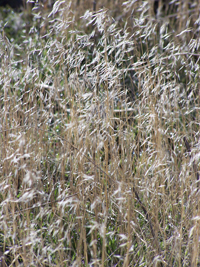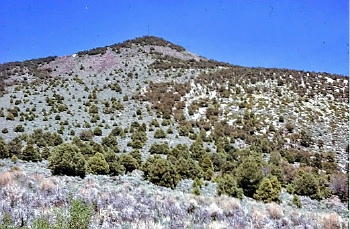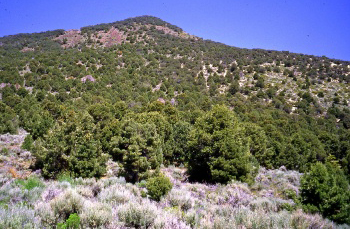Threats to Sagebrush Ecosystems

Cheatgrass Invasion
Cheatgrass (Bromus tectorum) is an annual grass native to Eurasia. Since the unintentional introduction of cheatgrass to the Intermountain West in the 1880’s, the exotic grass has invaded nearly 25 million acres (or nearly 1/3) of the Great Basin. As a short-lived, highly competitive species, cheatgrass develops and produces seed quickly, and then the plant dries and becomes a dangerous fuel for wildfires. Where exotic annual grasses have come to dominate sagebrush ecosystems, wildfires are burning more frequently (fire are returning to areas in less than 10 years where they used to burn once in 50 years or more). More frequent fire creates larger disturbed areas for cheatgrass to quickly invade, and more cheatgrass invasion results in more fire. Many plants native to the sagebrush steppe ecosystem are not able to survive these frequent fires and cannot compete with cheatgrass. In August 1999 alone, wildfires burned across 1.7 million acres of land in the Great Basin.
For more information about the Great Basin’s struggle with cheatgrass and efforts to restore the land, please visit the BLM’s Great Basin Restoration Initiative’s website at http://www.fire.blm.gov/gbri/index.html
A list of related publications can also be found on our Cheatgrass Invasion Bibliography.
Woodland Encroachment
In more moist portions of the Great Basin, conditions in the late 1800’s of wetter-than-average precipitation, few fires, and intensive livestock grazing, facilitated encroachment of juniper and pinyon trees in sagebrush ecosystems. Woodland encroachment has also changed the fire cycle in sagebrush communities. Before woodland encroachment, sagebrush communities burned every 10-50 years, with fires of low to mixed severity. In areas where woodlands dominate the sagebrush steppe, it could take more than 50 years for a fire to occur, and when it does, it is an extremely hot and intense fire. The change from a sagebrush steppe plant community to a juniper or pinyon woodland results in a dangerous increase in fuel for wildfire.
These repeat photos illustrate woodland encroachment in sagebrush steppe over a period of 32 years. Fuel loads have doubled, and most of the sagebrush ecosystem has been lost. Photos by R. Tausch
Shoshone Mountains, Nevada, June 1973

Shoshone Mountains, Nevada, June 2005

If you would like to learn more about juniper woodlands, you may access several publications by Dr. Richard Miller at http://oregonstate.edu/dept/EOARC/abouthome/scientists/rick.html. The publication, Biology, Ecology, and Management of Western Juniper, by Dr. Miller and others, offers comprehensive information on the subject.
You may also view a list of publications related to pinyon & juniper woodlands on our Pinyon and Juniper Woodlands Bibliography.
The book, Habitat Threats in the Sagebrush Ecosystem: Methods of Regional Assessment and Applications in the Great Basin, edited by Dr. Michael Wisdom and others, describes methods and example applications to identify and map threats to sagebrush habitats for the benefit of a wide array of associated species of conservation concern. This book may be ordered from the Alliance Communications Group.
At this time, relatively little scientific information is available to help land managers make decisions to protect healthy sagebrush systems and restore those that have been degraded. SageSTEP research is intended to help managers learn more about land management options. To learn more about SageSTEP research, visit the About the Project link.
Contact
Lisa Ellsworth
Project Co-coordinator
Dpt. Fisheries & Wildlife
Oregon State University
Corvallis, OR 97330
Email
(541) 737-0008
Beth Newingham
Project Co-coordinator
GB Rangelands Research
USDA Ag. Res. Service
Reno, NV 89512
Email
(775) 784-6057 ext. 233
Lael Gilbert
Outreach Coordinator
Utah State University
5215 Old Main Hill
Logan, Utah 84322-5215
Email
(435) 797-8455

Site Designed by Kite Media